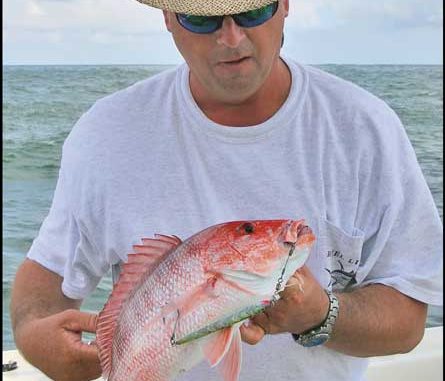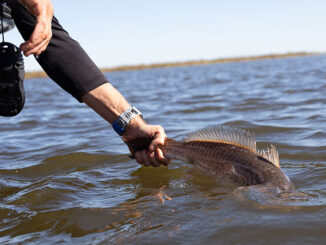
Though NMFS says stocks are in danger, red snapper fishing in the Ship Shoal blocks is ridiculously good right now.
There wasn’t the slightest fold or crease in Old Glory at the Houma Hampton Inn at 4:30 a.m. It looked like the service crew had mistakenly washed it in with all the sheets, pressed it, then applied a coating of heavy starch.
That wasn’t a good sign considering the wind usually picks up after the sun rises.
It wouldn’t have been that bad had I been scheduled to lounge around by the pool with a cute umbrella drink in my hand. Unfortunately, I was scheduled to get into Capt. Tommy Pellegrin’s boat within the hour, and there wasn’t any getting around the fact that he was going to have that boat pointed toward the unprotected water south of Cocodrie.
I greeted Mainstream Marketing representative Drew Davis and Mustad Regional Sales Manager Jeff Pierce at the coffee pot. Both had distant stares that I just knew were focusing on some far-away fantasy of fishing at least one day of the year without any danged wind blowing.
We tried our best to rationalize away the rigid flag and buoy our spirits by assuring each other that The Weather Channel had predicted 5- to 10-mph winds. Somebody said something about how one weatherman had said something about the winds being less below a particular latitude, but it was too early in the morning to try to make any sense out of that.
Davis and I were thanking our lucky stars, the Lord and anybody else we could think of that Pellegrin had some comfy-looking bean-bags on board that would smooth our ride out to Ship Shoal. Unfortunately for Pierce, who is from Florida, the purple-and-gold beanbags were plastered with LSU logos. We didn’t want him to feel nauseous and dirty, so we took the bags.
The water actually calmed a bit after we cleared the shelf, and everybody on board was amazed that we were going to have at least some halfway decent fishing conditions. We must have been south of that latitude the weatherman mentioned earlier in the morning.
Pellegrin pulled the boat up to rig 209B, and immediately pointed to his Lowrance depthfinder. The screen was almost black with some of the biggest fish arches I had ever seen.
“See how these marks are large and spread out,” said Pellegrin. “When you see returns like that, they’re larger fish — exactly how snapper set up. It’s not a tight grouping, and it’s not little-bitty dots.”
The snapper had been biting a little bit later in the day, so Pellegrin wasn’t sure what we would find as we stopped our pogies and jigging spoons at the end of a 30 count. It didn’t take long for Davis to get things started with a decent-sized mangrove snapper on a Shimano Jigging Iron.
Almost as soon as Davis landed his fish, Pierce was reeling in the first red snapper of the day on his jigging iron. Even though we pogie soakers at the back of the boat were still waiting on our first bite, it looked like we wouldn’t have to wait until the anticipated afternoon bite.
Davis and Pierce continued to pull in snapper over the fore of Pellegrin’s boat. Not being one to remain stubborn when getting my behind handed to me on a platter, I made my way to the front to see exactly what those guys were doing.
“It’s pretty simple,” said Pierce. “Drew and I are fishing these Shimano Butterfly Jigging Irons with two Mustad single-assist hooks. We’re basically just getting a reaction bite by running our jigs through the fish.”
Pierce explained that there are many times when anglers are positioned over fish on a rig or over a hard bottom that, for whatever reason, are just not eating live or cut bait. He theorized that dropping these jigging irons down to the fish triggers their predatory instincts because they look like fleeing baitfish. They see it, and they jump on it.
There was more to fishing these jigging irons than Pierce was letting on, though. While watching him fish like a punch-drunk boxer wildly flailing punches at the air, I noticed that fishing these jigging irons took a lot of effort. But the fish that Pierce and Davis continued to catch proved to me that the reward was worth the exertion.
“If you just drop it down and bounce it, you don’t typically get the bites,” Pierce said. “The easiest way to do it is to almost hold the reel handle steady and reel the rod around it. This gives the jig a different action and makes it move in more of a side-to-side motion. You can catch fish bouncing it up and down, but you tend to get better bites from bigger fish by making it flutter side to side.”
Pierce added that it is important to select a jig weight based on depth and somewhat on the size of the targeted fish. The key is to use the lightest you can get away with because working these babies will wear you out. Pierce has found the 110-gram jig to be a good all-around size for snapper, amberjack and grouper.
I left Pierce alone so he could battle another snapper, and walked back to the cabin to get a little more offshore education from Pellegrin. There was apparently more going on than my eye could see, and he explained why we were positioned where we were on the rig.
“These snapper will get inside the rig if they have to,” he said. “It all has to do with the water clarity. The clearer the water is, the farther away from the rig they’ll be, and the dirtier it is, the closer to the rig they get. They’ll get as far away as they can while still being able to see their ‘house.’ I’ve seen them 200 yards off a rig before in real clear water.”
It wasn’t just the water clarity that determined where Pellegrin positioned his boat, though. He pointed out all the hardtails on this particular side of the rig, and explained that those fish were there because it was the head of the current. This upcurrent side and a little bit to the side are where snapper usually hold.
The pogie soakers eventually started catching up to the butterfly dancers, but just as soon as the action started heating up, Pellegrin called for all lines in because we were going to make a move to another rig in the same block. Never wanting to leave fish to find fish, I had to quiz Pellegrin about the move.
“We’re just looking for something bigger,” he explained. “We caught some nice fish here with some big mangroves, but I believe we’re looking for the big boys today. All these surrounding rigs make what we call a clump. This is the center one, and all the others make a circle around it.
“Anybody who goes out of Terrebonne Parish knows this as a regular spot. People come here because it’s pretty easy to get to, it’s not too far out and it’s got a load of fish — there’s no reason not to fish here.”
We found the big boy on the new rig. Pellegrin’s deck hand, Todd Schouest, was actually getting in a little fishing at the new rig since this wasn’t a paid charter, and he knew he had a good one when he first felt the pressure. After a lot of grunting and groaning, Pellegrin’s son, Capt. Eric Pellegrin, got the assist as he brought the bubble-eyed, 19-pound beast of a red snapper over the gunwale.
While I treated Schouest like a runway model for almost 20 minutes, Pellegrin pointed out how far we had drifted off the rig. I didn’t think anything of it, but Pellegrin knew that leaving the hot bite would cause us a little trouble. Sure enough, we found the bite slow to almost nonexistent when we got back to the rig.
“We were catching fish fast, and everybody was hooking fish,” he said. “Everything was going well then we caught that big fish. We moved off to get some pictures, and quit fishing. In that length of time, the bite turned off.”
Pellegrin went on to explain that we had created a deep chum-line off the hook because all the snapper were racing in to get at the pieces of bait that were falling off as a fish was struggling on the hook. When the chum line shut off while we drifted off, the fish shut off too.
“They were down there fighting each other and acting real aggressive,” Pellegrin said. “They all got a little something to eat, and now, instead of being aggressive, they’re down there with a belly full realizing they don’t have to fight for those pieces of bait anymore. You might can turn them back on in about 30 minutes to an hour, but a good rule to follow is that if you have a good bite going, don’t stop fishing.”
The good thing about where we were fishing, though, was that there were several more rigs to go fish. Since these fish had stopped biting, we simply moved to another rig. What I saw at each of the rigs we fished made me question Pellegrin about his opinion of the new two-fish red snapper limit.
“National Marine Fisheries said the red snapper are supposedly overfished,” he said. “That means they believe there aren’t as many fish left, and they don’t want us to catch as many. I don’t see it, though. This year has been better than last year, which was better than the year before that.”
Pellegrin has not only seen the red snapper fishing getting better over the last few years, he has also noticed that the size is better. With the 19-pound snapper we caught this particular day, it made a string of three days that Pellegrin’s boat landed big fish. He had four over 18 pounds two days before, with the largest being 22 pounds and one 20-pound fish the day after that.
With all the red snapper his boat has landed this year, Pellegrin had to question whether there really wasn’t a lot of small snapper swimming around in the Gulf. In fact, one place he fishes almost leaves him no doubt that there are enough fish to go around.
“When we go inland, there are so many small snapper that we call those close-in rigs the piranha wells,” he added. “We can’t even fish them for triggerfish or anything else because there are so many of those small snapper.”
Pellegrin explained that red snapper fishing has been so good this year that it has been like hardhead catfish fishing under a fish-cleaning station. He thinks it’s hard to go anywhere in the Ship Shoal area and not catch a bunch of fish.
To top it off, Pellegrin explained that we only had three to four anglers fishing for most of the day with two of them sticking with the butterfly jigs. We weren’t even putting a lot of bait in the water to get a frenzy going. I could only imagine how much better it would be, if that were even possible, if we had six anglers all taking on the role of pogie soaker.


